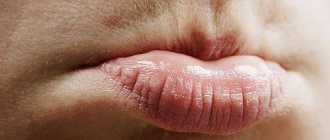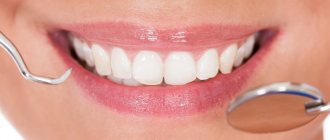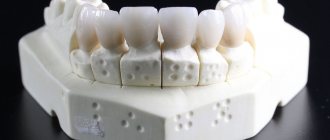Changing the color of tooth enamel is an alarming signal that cannot be ignored. Dark spots can be associated not only with the consumption of coloring foods and drinks, but also with the development of various pathological processes. If the tooth has turned black at the root, you should contact your dentist as soon as possible. Do not wait for pain and other symptoms to appear, as they indicate extensive damage to hard tissues or inflammation of the dental nerve. It is easier to treat any disease in the early stages, so do not delay visiting a doctor.
Why do teeth turn black?
External and internal factors can change the color of teeth.
External reasons
Poor oral hygiene
If a person brushes his teeth incorrectly or not well enough, plaque remains on them, which accumulates over time and turns into a kind of shell of the teeth. Bacteria actively multiply in dental plaque, and their metabolic products thicken this layer and make it more durable. Tooth enamel is quite resistant to colored pigments found in food and drinks. Such substances cannot penetrate deeply, so they are quickly removed with liquid, saliva and toothpaste. But dental plaque is very susceptible to such dyes. Especially to pigments contained in:
- Strong coffee and tea;
- Berries, fruits and vegetables with dark skin or pulp - blueberries, blackberries, mulberries, beets, etc.;
- Red wine;
- Turmeric;
- Drinks with synthetic colors.
Unlike tooth enamel, plaque has a porous structure in which pigment particles settle and color it. It is impossible to completely remove dye particles from the pores by regular brushing of teeth, and over time they become clogged with a new layer of plaque. The more plaque coats the enamel, the darker the teeth become.
Smoking
There is even such an expression as “smoker’s teeth.” People who smoke a lot and often are easily recognized by their yellow or even dark brown teeth. This color comes from the resins found in cigarette smoke.
These hard and sticky substances settle on the surface of the teeth, literally sticking to it. This is what causes dark plaque on the teeth of smokers. It is difficult to remove such darkening of the enamel using regular toothpaste and a brush. Especially on the lateral surfaces of the teeth. Over time, the layer of resinous plaque becomes thicker and the teeth turn blacker.
Internal reasons
Let's start with the fact that the color of teeth does not depend on tooth enamel, which is transparent, but on the color of dentin. Accordingly, a change in shade is a consequence of some processes in this fabric.
Caries
The most common cause of black teeth is caries. It may appear as brown or gray spots. This is how dentin destroyed by bacteria is stained. The more tissue is destroyed, the darker and more extensive the darkening. If the tooth is darkened but does not hurt, this may mean that caries has not yet reached the pulp.
Secondary caries appears as dark stripes. They form between the filling and dentin if, during filling, the doctor did not completely remove the damaged tissue, did not “clean” the cavity, or if the filling did not fit tightly enough to the tooth tissue.
Filling material
Some dental canal filling materials contain substances that can stain dentin. Nowadays they are rarely used and only by “old school” specialists, but 10-15 years ago they were very common. The substances gradually stain the hard tissue of the tooth. Accordingly, a person who had his canals filled with such material 10 years ago is now seeing a darkened tooth.
"Metal" fillings
It is also a filling material that tends to change the color of the tooth over time. To increase the strength of the filling, silver amalgam is added to its composition. Now this material is considered obsolete and is practically not used in modern dentistry. But there are quite a lot of people who have had such fillings installed, and most of them are dissatisfied with the color of the teeth treated in this way.
Injuries
A tooth is a living organ that receives nutrition and oxygen through blood vessels. If for some reason the vessels are damaged, for example due to a blow, and blood enters the dentin, the tooth first becomes red, then purplish-brown, and over time darkens even more. If a tooth turns brown, the cause is usually injury.
Removal of dental nerve
After depulpation and removal of the neurovascular bundle, the tooth becomes dead. It no longer receives the nutrition and minerals that are necessary to maintain the natural color of dentin. Therefore, pulpless teeth darken over time. Plus, secondary caries often develops in them.
Cervical caries
Cervical caries is localized on the neck of the tooth - the place where the enamel comes into contact with the gum. This pathological process occurs very quickly, which makes it one of the most dangerous types of this disease. Cervical caries can develop into pulpitis, periodontitis or a root pathological process within just a few months. It is much faster than localized, for example, on the vestibular or occulus surface.
Cervical caries requires immediate treatment. If the disease is started, the pathological process will quickly “spread” to the roots of the tooth. In this case, the patient will begin to experience acute pain. When the roots are destroyed, it becomes impossible to save the tooth, and the only way to “treat” is removal.
But there are also advantages. If cervical caries is detected at an early stage, when the pathological process has not yet affected the dentin and roots of the tooth, this disease can be cured using a conservative method. The dentist will perform fluoridation and remineralization of the enamel, restoring its strength. In this case, preparation is not required or minimal.
If the pathological process has reached the dentin - the patient is concerned not only about the darkening of the tooth, and increased sensitivity, as well as pain - then treatment is carried out by filling. The dentist removes the destroyed tissue, then cleans the tooth from the remains of harmful microorganisms and closes it with a filling.
The most common cause of cervical caries is insufficient dental hygiene. To prevent this disease, it is necessary to brush your teeth regularly, at least 2 times a day, use floss (dental floss), and, if you are predisposed, use an irrigator.
Black teeth in children
The condition of “baby” teeth in children directly depends on the general condition of the body. Color changes can be caused by:
- Disorders of the gastrointestinal tract;
- Dysbacteriosis;
- Taking certain antibiotics;
- Decreased immunity;
- Fungus;
- Calcium deficiency;
- Excess fluoride and a number of other factors.
Just like permanent teeth, caries can develop in baby teeth. If a child’s tooth is black and hurts, then the destruction process has reached the internal tissues - the pulp.
Priestley's Raid
Parents often turn to the pediatric dentist with complaints about black plaque on the teeth that forms in the gum area. Despite its rather frightening appearance, this condition is usually not dangerous. Such deposits are called Priestley's plaque. The reason for black plaque on teeth is the development of the child’s digestive system, its adaptation to “adult” food. When the process is completed, the plaque disappears. But if you find black deposits on your child’s teeth, you still need to see a dentist. Often, caries develops under such plaque. You can stop this process at the initial stage using simple and painless methods.
Features of the disease
This type of caries is especially dangerous and unpleasant, as it has some peculiarities in its course and location. Its manifestations are associated with the following factors:
- Carious lesions are localized in the weakest area near the neck of the tooth (this is the part covered by the gum). In this zone, the enamel is also weakly mineralized, and this factor enhances the development of caries.
- Circular distribution. Cervical caries affects the tooth in a circle, covering increasingly larger areas. As a result, part of it may break off, since the integrity will be broken in many places.
- Damage to the front teeth. An unpleasant feature of gingival caries is its frequent location on the incisors. A person experiences psychological discomfort when he has to talk, smile, laugh.
Under the influence of the bacteria Streptococcus Mutans, which causes the development of the disease, the enamel and dentin underneath are actively destroyed. Inflammation can spread to the pulp and ultimately lead to pulpitis or periodontitis.
What can you do about black teeth at home?
At home, it is possible to combat the darkening of teeth only in cases where the cause is external - plaque or deposits of tobacco tar. You can try to eliminate them with a highly abrasive toothpaste. But this means:
- Ineffective if the plaque is dense and hard;
- Cannot be used continuously as abrasive particles damage tooth enamel.
We do not recommend using home teeth whitening complexes offered by sellers on the Internet. They usually contain aggressive components that, together with plaque, destroy tooth enamel.
Contraindications
It is necessary to refuse the intracanal bleaching procedure in the following cases:
- with increased tooth sensitivity;
- for dental diseases and inflammatory processes of the oral cavity;
- if the patient has caries or periodontitis;
- women during lactation should refrain from the procedure;
- Whitening is contraindicated for children and adolescents under 16 years of age.
Any of these factors can lead to undesirable consequences, so if at least one of them is present, you should think about the advisability of whitening and weigh all the possible risks.
Black teeth: what to do
The best way to solve the problem of black teeth is to see a doctor. The dentist will determine the cause of the color change and tell you how it can be eliminated. If your teeth have darkened due to the accumulation and staining of plaque, professional hygiene will help restore them to their original color. For example, contactless cleaning using the Air-flow method. If, in addition to plaque, tartar has formed on the teeth, this procedure can be combined with ultrasonic cleaning.
To eliminate the blackness that appears due to bacterial damage to dentin, you need to cure a carious tooth. This also applies to secondary caries. There are methods for lightening teeth that have changed color due to the components of filling materials. They are effective if the tooth has darkened by no more than 1-2 shades. If it is impossible to restore the natural color of the tooth, the dentist will suggest covering it with a crown or installing a veneer.
Our clinic’s specialists will restore the whiteness of your teeth, no matter why they have darkened. To consult with a doctor, make an appointment for a free initial appointment using the form on the website or by phone.
Whitening prognosis and complications
Whitening a dead tooth is a fairly serious procedure that involves chemical action on tooth enamel. Therefore, before carrying out it, you should familiarize yourself with possible complications:
- the fragility of the result obtained, which necessitates repeated bleaching;
- The enamel of a dead tooth does not always acquire the same shade as healthy teeth. Even after lightening, the enamel can stand out from the rest;
- the enamel coating of a pulpless tooth after bleaching becomes even more fragile, in some patients it even begins to crumble and collapse;
- When applying the whitening component, the gums are irritated, so it should be done with extreme caution in patients prone to gingivitis, periodontitis and other pathologies.
Only a specialist can accurately determine whether intracanal bleaching is worthwhile or whether to look for safer alternative methods.
The Berezka dental clinic employs highly qualified specialists who can be trusted with complete confidence in tasks of any complexity and without worrying about unpleasant consequences.











